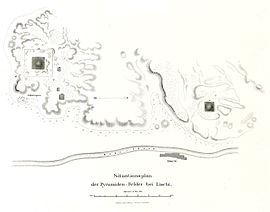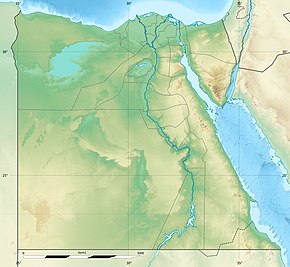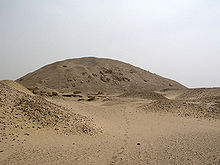el-Lish
| Itji-taui in hieroglyphics | |||||
|---|---|---|---|---|---|
Itji-taui Jṯj-t3wj |
|||||
| Map of the necropolis of Lischt according to Karl Richard Lepsius (north is on the right): on the right the Amenemhet I pyramid , on the left the Sesostris I pyramid | |||||
El Lisht's location in Egypt |
El-Lisht ( Arabic اللشت, DMG al-Lišt ) is a village in Egypt , about 60 kilometers south of Cairo on the west side of the Nile on the edge of the Libyan desert . El-Lisht is located in the Markaz al-ʿAyāt of the al-Jiza governorate ; the 2006 census counted 7,163 inhabitants.
An ancient Egyptian necropolis is located directly to the west of the village of El Lisht . It consists of the royal pyramid districts of the two rulers Amenemhet I and Sesostris I from the 12th dynasty as well as several mastaba graves of high officials and hundreds of simple shaft graves .
topography
The cemetery of Lisht was two limestone - plateaus established, the m by a 500 wide Wadi be separated. There are also numerous smaller wadis that lead from the southern plateau to the northeast towards the modern village of Lischt. The southern plateau has steep slopes at the southern end that were used as quarries in the Middle Kingdom .
history
The oldest monuments in Lischt are a series of rock tombs on the southern slopes of the northern plateau. The excavators of the pyramid districts originally thought they were buildings of the Middle Kingdom. On closer examination, however, finds from the Old Kingdom came to light.
The first king ( Pharaoh ) of the 12th dynasty , Amenemhet I , established a new capital , called "Itji-taui" , for political reasons . From here it was easier to control the Nile Delta , and perhaps he has already planned to cultivate the Fajum marshland . Itji-taui has not yet been precisely located and is still being sought. Due to the existence of two pyramids , however, the associated necropolis in today's el-Lisht is known and Itji-taui should not have been far from it.
The two rulers Amenemhet I and Sesostris I had their royal tombs built in el-Lisht. The burial grounds of the high officials under these rulers are also located here. The tomb of the treasurer Mentuhotep even had its own way. His well-preserved, richly decorated sarcophagus was found in the burial chamber .
El-Lisht remained an important necropolis until the 13th Dynasty , but after the reign of Sesostris I mainly simple shaft graves were dug. In the Second Intermediate Period , parts of the Amenemhet I pyramid district were converted into a settlement. Later the necropolis largely sank into insignificance. Only in Roman times were some graves and agricultural buildings built again. In the area directly east of the mortuary temple of the Amenemhet I pyramid, there is also an extensive Islamic cemetery that is still in use today .
Research history
The first documentation of the necropolis of Lischt was carried out by John Shae Perring in 1839 . The publication took place in 1842 by himself and by Richard William Howard Vyse . Carl Richard Lepsius visited el-Lischt during his Egypt expedition 1842-1846 and documented the ruins there between March and May 1843. He added the two royal pyramids to his list of pyramids under the numbers LX and LXI .
Gaston Maspero was the first to enter the interior of the two pyramids in 1882. The first systematic excavations took place in 1894/95 under Joseph-Étiennte Gautier and Gustave Jéquier . Between 1906 and 1934, a research team from the Metropolitan Museum of Art under the direction of Albert M. Lythgoe (1906-1914), Ambrose Lansing (1916-1918 and 1923-1934) and Arthur C. Mace (1920-1922 ) dug here in 14 campaigns ), although no publications apart from preliminary reports appeared at the time. Subsequent excavations were then carried out between 1984 and 1991 under Dieter Arnold . In 1988 he published the first complete excavation publication of the Sesostris I pyramid. In 1992, with the collaboration of his wife Dorothea Arnold and his son Felix Arnold , another volume on the pyramid complex followed. In 1990 Felix Arnold also presented a volume on the workers' inscriptions found in the pyramid complex. In 2008 another volume by Dieter Arnold on the mastaba graves in Lischt followed. A complete publication on the Amenemhet I pyramid took place in 2016 in the form of a volume by Dieter Arnold on the architecture of the pyramid complex and another volume by Peter Jánosi on the reliefs.
Ahmed Abdel-Hamid carried out further excavations in Lischt from 1991 to 1994 . During the 2011 revolution in Egypt , the necropolis fell victim to massive illegal excavations . Sarah Parcak from the University of Alabama has been evaluating satellite images since 2011 to take stock of the damage . In May 2015, there was documentation on site, during which Parcak discovered several previously unknown shaft graves that had been uncovered by the robbery graves. In cooperation with the Egyptian Ministry of Antiquities , further ongoing investigations were carried out, led by Parcak and Mohamed Youssef , the director of the archaeological site of Dahshur . In February 2016, the previously unknown tomb of the high official Intef of the 12th dynasty was discovered south of the Sesostris I pyramid. Intef had the titles of keeper of seals, treasury chief and chief of the army.
Funerary monuments in El Lisht
Lischt-Nord
Rock tombs of the Old Kingdom
The graves of the Old Kingdom are located on the southern slopes of the northern plateau and have so far not been adequately explored. The only investigation took place during the 1931/32 excavation season of the Metropolitan Museum, as the graves were prepared as temporary accommodation for workers who were involved in the excavations in the district of the Sesostris I pyramid. The results of the investigation were only presented in a preliminary report which did not contain any information on the exact number, location or dimensions of the graves. The graves were initially thought to be Middle Kingdom buildings. However, it quickly became apparent that their nearly square burial chambers were too small for a typical coffin of the Middle Kingdom. One of the graves had four pits in the floor of the chamber. In one of them a round alabaster plaque, a copper basin and a ceramic jug were discovered, all of which date back to the Old Kingdom. Furthermore, several Roman burials were found in this grave. In the forecourt of another grave, a well-preserved sacrificial tablet and a stele heavily weathered by salt were discovered. A few other graves examined did not contain any finds.
The Amenemhet I pyramid
Mastabas of the Middle Kingdom around the Amenemhet I pyramid
- Grave 384 of Rehuerdjersen ( treasurer )
- Mastaba 400 des Antefiqer ( vizier , mayor of the pyramid city)
- Tomb 470 of Senimeru (keeper of the seals)
- Grave 493 of the night (senior asset manager, seal keeper)
- Grave 758 of Sesostris (vizier, chief reading priest , head of the works)
- Grave 954 (common grave)
- Grave 956 (common grave?)
Graves in an unknown location in Lischt-Nord
- Grave of Sobeknacht (Supreme Treasurer )
- Tomb of Inherethetep (keeper of the seals)
- Grave of Sehetepibreseneb ( Wab priest )
- two anonymous graves
Lish-South
The Sesostris I pyramid
The Sesostris I pyramid has a cult pyramid and nine queen pyramids .
Mastabas of the Middle Kingdom around the Sesostris I pyramid
- Mastaba of Senwosretanch ( high priest of Ptah )
- Mastaba of Sesostris (?) (Steward)
- North Mastaba of Intef (?)
- "French Tomb"
- Mastaba of Imhotep (Head of Field)
- Mastaba of Mentuhotep (vizier and treasurer)
- "South- Khor Tomb A"
- "South- Khor Tomb B"
- Grave A
- Grave B of Djehuti (magazine manager)
- Grave C of the Ip ...
- Grave D
- (Grave E, existence hypothetical, as only an enclosing wall was exposed)
- Grave F
- Mastaba des Sehetepibreanch (High Priest of Ptah)
- East grave
literature
General overview
- Dieter Arnold : Lisht. In: Donald B. Redford (Ed.): The Oxford Encyclopedia of Ancient Egypt. Oxford University Press, Oxford 2001, ISBN 0-19-513822-8 , pp. 294-297.
- Blinks. In: Hans Bonnet : Lexicon of the Egyptian religious history. 3rd, unchanged edition. Nikol, Hamburg 2000, ISBN 3-937872-08-6 , p. 426 f.
- Zahi Hawass : The Treasures of the Pyramids. Weltbild, Augsburg 2004, ISBN 3-8289-0809-8 , pp. 330–331.
- Blinks. In: Wolfgang Helck / Eberhard Otto : Small Lexicon of Egyptology. 4th, revised edition. Harrassowitz, Wiesbaden 1999, ISBN 3-447-04027-0 , p. 173.
- Christian Hölzl : el-Lisht. In: Kathryn A. Bard (Ed.): Encyclopedia of the Archeology of Ancient Egypt. Routledge, London 1999, ISBN 0-415-18589-0 , pp. 447-49.
- Mark Lehner : Secret of the Pyramids. ECON, Düsseldorf 1997, ISBN 3-572-01039-X , pp. 168-173.
- Bertha Porter , Rosalind LB Moss : Topographical Bibliography of Ancient Egyptian Hieroglyphic Texts, Reliefs and Paintings. IV. Lower and Middle Egypt (Delta and Cairo to Asyût). Griffith Institute, Oxford 1968, pp. 77-85 ( PDF; 14.3 MB ).
- Rainer Stadelmann : The Egyptian pyramids. From brick construction to the wonder of the world (= cultural history of the ancient world . Volume 30). 2nd, revised and expanded edition. Philipp von Zabern, Mainz 1991, ISBN 3-8053-1142-7 , pp. 233-235.
- Miroslav Verner : The pyramids (= rororo non-fiction book. Volume 60890). Rowohlt, Reinbek bei Hamburg 1999, ISBN 3-499-60890-1 , pp. 434-445.
Excavation publications
- Dieter Arnold: The Pyramid of Senwosret I (= Publications of the Metropolitan Museum of Art Egyptian Expedition. Volume 22). Metropolitan Museum of Art, New York 1988, ISBN 0-87099-506-5 ( online ).
- Dieter Arnold: The Pyramid Complex of Senwosret I (= Publications of the Metropolitan Museum of Art Egyptian Expedition. Volume 25). Metropolitan Museum of Art, New York 1992, ISBN 0-87099-612-6 ( online ).
- Dieter Arnold: Middle Kingdom Tomb Architecture at Lisht (= Publications of the Metropolitan Museum of Art Egyptian Expedition. Volume 28). Metropolitan Museum of Art, New York 2008, ISBN 978-1-58839-194-0 ( online ) (publication of all mastabas excavated so far).
- Dieter Arnold: The Pyramid Complex of Amenemhat I at Lisht. The Architecture (= Publications of the Metropolitan Museum of Art Egyptian Expedition. Volume 29). Metropolitan Museum of Art, New York 2016, ISBN 978-1-58839-604-4 .
- Felix Arnold : The South Cemeteries of Lisht II. The Control Notes and Team Marks (= Publications of the Metropolitan Museum of Art Egyptian Expedition. Volume 23). Metropolitan Museum of Art, New York 1990, ISBN 978-0-30009-161-8 ( online ).
- Joseph-Étiennte Gautier , Gustave Jéquier : Fouilles de Lisht. In: Revue archéologique . Ser. 3, Vol. 29, 1896, pp. 39-70 ( online ).
- Joseph-Étiennte Gautier, Gustave Jequier: Memoires sur les Fouilles de Lisht (= Memoires de l'Institut français d'archéologie orientale du Caire. Volume 6). Cairo 1902 ( online ).
- William C. Hayes : The Texts in the Mastabeh of Se'n-Wosret-'Ankh at Lisht (= Publications of The Metropolitan Museum of Art. Egyptian Expedition. Volume 12). The Metropolitan Museum of Art, New York 1937 ( online ).
- Peter Jánosi : The Pyramid Complex of Amenemhat I at Lisht. The Reliefs (= Publications of the Metropolitan Museum of Art Egyptian Expedition. Volume 30). Metropolitan Museum of Art, New York 2016, ISBN 978-1-58839-605-1 .
- Ambrose Lansing : The Egyptian Expedition 1916-1919: I. Excavations on the Pyramid of Sesostris I at Lisht. Seasons of 1916-17 and 1917-18. In: The Metropolitan Museum of Art Bulletin. Volume 15, No. 7, July 1920, pp. 3-11 ( JSTOR 3254174 ).
- Ambrose Lansing: The Museum's Excavations at Lisht. In: The Metropolitan Museum of Art Bulletin. Volume 19, No. 12, December 1924, pp. 33-43 ( JSTOR 23031110 ).
- Ambrose Lansing: The Museum's Excavations at Lisht. In: The Metropolitan Museum of Art Bulletin. Volume 21, No. 3, March 1926, pp. 33-40 ( JSTOR 3254818 ).
- Ambrose Lansing: The Egyptian Expedition 1931-1932: The Museum's Excavations at Lisht. In: The Metropolitan Museum of Art Bulletin. Vol. 28, No. 4/2, April 1933, pp. 3-22 ( JSTOR 3254981 ).
- Ambrose Lansing, William C. Hayes: The Egyptian Expedition: The Excavations at Lisht. In: The Metropolitan Museum of Art Bulletin. Volume 28, No. 11/2, November 1933, pp. 4-38 ( JSTOR 3255344 ).
- Ambrose Lansing, William C. Hayes: The Egyptian Expedition: The Excavations at Lisht. In: The Metropolitan Museum of Art Bulletin. Volume 29, No. 11/2, November 1934, pp. 4-41 ( JSTOR 3257012 ).
- Albert M. Lythgoe : The Egyptian Expedition. In: The Metropolitan Museum of Art Bulletin. Vol. 2, No. 4, April 1907, pp. 60-63 ( JSTOR 3253285 ).
- Albert M. Lythgoe: The Egyptian Expedition. In: The Metropolitan Museum of Art Bulletin. Vol. 2, No. 7, July 1907, pp. 113-117 ( JSTOR 3253292 ).
- Albert M. Lythgoe: The Egyptian Expedition. In: The Metropolitan Museum of Art Bulletin. Volume 2, No. 10, October 1907, pp. 163-169 ( JSTOR 3253176 ).
- Albert M. Lythgoe: The Egyptian Expedition. In: The Metropolitan Museum of Art Bulletin. Volume 3, No. 5, May 1908, pp. 83-86 ( JSTOR 3253348 ).
- Albert M. Lythgoe: The Egyptian Expedition: II. The Season's Work at the Pyramids of Lisht. In: The Metropolitan Museum of Art Bulletin. Volume 3, No. 9, September 1908, pp. 170-173 ( JSTOR 3252935 ).
- Albert M. Lythgoe: The Egyptian Expedition. In: The Metropolitan Museum of Art Bulletin. Volume 4, No. 7, July 1909, pp. 119-123 ( JSTOR 3252459 ).
- Arthur C. Mace : The Egyptian Expedition: III. The Pyramid of Amenemhat. In: The Metropolitan Museum of Art Bulletin. Volume 3, No. 10, October 1908, pp. 184-188 ( JSTOR 3252551 ).
- Arthur C. Mace: The Egyptian Expedition: Excavations at the North Pyramid of Lisht. In: The Metropolitan Museum of Art Bulletin. Volume 9, No. 10, October 1914, pp. 203, 207-222 ( JSTOR 3254066 ).
- Arthur C. Mace: The Egyptian Expedition: 1920-1921: I. Excavations at Lisht. In: The Metropolitan Museum of Art Bulletin. Volume 16, No. 11/2, November 1921, pp. 5-19 ( JSTOR 3254484 ).
- Arthur C. Mace: The Egyptian Expedition: Excavations at Lisht. In: The Metropolitan Museum of Art Bulletin. Volume 17, No. 12/2, December 1922, pp. 4-18 ( JSTOR 3254276 ).
- Arthur C. Mace, Herbert E. Winlock : The Tomb of Senebtisi at Lisht (= Publications of the Metropolitan Museum of Art Egyptian Expedition. Volume 1). The Gillis Press, New York 1916 ( online ).
- Gaston Maspero : Étude de mythologie et d'archéologie égyptiennes. Volume 1, Paris 1893, pp. 148-149 ( online ).
- Sarah Parcak : Archaeological Looting in Egypt: A Geospatial View (Case Studies from Saqqara, Lisht, and el Hibeh). In: Near Eastern Archeology. Volume 78/3, 2015, pp. 196-203 ( online ).
- William Kelly Simpson : The Pyramid of Amen-em-het I at Lisht: The Twelfth Dynasty Pyramid Complex and Mastabehs. Dissertation, Yale 1954.
Web links
Individual evidence
- ↑ Egyptian census data 2006 ( page no longer available , search in web archives ) Info: The link was automatically marked as defective. Please check the link according to the instructions and then remove this notice.
- ^ Dieter Arnold: Middle Kingdom Tomb Architecture at Lisht. 2008, p. 63.
- ↑ Dieter Arnold: The Pyramid Complex of Senwosret I. 1992, p. 100.
- ^ Ambrose Lansing: The Egyptian Expedition 1931-1932: The Museum's Excavations at Lisht. 1933, pp. 21-22.
- ↑ John Shae Perring, EJ Andrews: The Pyramids of Gizeh. From Actual Survey and Admeasurement. Volume 3, Fraser, London 1843, p. 19, plate 17 ( online ).
- ^ John Shae Perring, Richard William Howard Vyse: Operations carried on at the Pyramids of Gizeh in 1837: With an Account of a Voyage into Upper Egypt, and Appendix. Volume 3, Fraser, London 1842, pp. 77-78 ( online ).
- ↑ Monuments from Egypt and Ethiopia. Text. First volume. Lower Egypt and Memphis. Edited by Eduard Naville and Ludwig Borchardt, edited by Kurt Sethe. Hinrichs, Leipzig 1897, pp. 212-216 ( online ).
- ↑ Gaston Maspero: Étude de mythologie et d'archéologie égyptiennes. Volume 1, Paris 1893, pp. 148-149 ( online ).
- ↑ Joseph Étiennte Gautier, Gustave Jéquier: Fouilles de Lisht. In: Revue archéologique. Ser. 3, Vol. 29, 1896, pp. 39-70 ( online ).
- ^ Dieter Arnold: The Pyramid of Senwosret I. Metropolitan Museum of Art, New York 1988 ( online ).
- ^ Dieter Arnold: The Pyramid Complex of Senwosret I. Metropolitan Museum of Art, New York 1992 ( online ).
- ^ Felix Arnold: The South Cemeteries of Lisht II. The Control Notes and Team Marks. Metropolitan Museum of Art, New York 1990 ( online ).
- ^ Dieter Arnold: Middle Kingdom Tomb Architecture at Lisht. Metropolitan Museum of Art, New York 2008 ( online ).
- ^ Dieter Arnold: The Pyramid Complex of Amenemhat I at Lisht. The Architecture. Metropolitan Museum of Art, New York 2016.
- ↑ Peter Jánosi: The Pyramid Complex of Amenemhat I at Lisht. The reliefs. Metropolitan Museum of Art, New York 2016.
- ↑ Dieter Arnold: Lisht. In: The Oxford Encyclopedia of Ancient Egypt. 2001, p. 296.
- ^ Sarah Parcak: Archaeological Looting in Egypt: A Geospatial View (Case Studies from Saqqara, Lisht, and el Hibeh). 2015, pp. 199–202.
- ↑ Nevine El-Aref: Egyptian Middle Kingdom tomb discovered at El-Lisht . In: Ahram Online. February 23, 2016.
- ^ Gallery: Archaeological mysteries hidden in satellite images . In: ideas.ted.com. 17th February 2016.
- ^ Ambrose Lansing: The Egyptian Expedition 1931-1932: The Museum's Excavations at Lisht. 1933, p. 22, fig. 19, 20.
Coordinates: 29 ° 34 ' N , 31 ° 14' E



